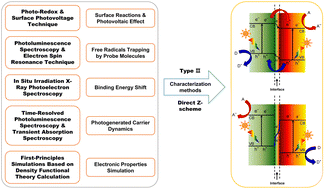Probing interfacial charge transfer in heterojunctions for photocatalysis
Abstract
Photocatalytic reactions can sustainably utilize inexhaustible solar energy for environmental remediation and conversion of photon energy into chemical energy, and thereby show great potential in alleviating the environmental stress and energy crisis. In particular, the constructed heterojunction photocatalysts, typically represented by type II and direct Z-scheme systems, possess many advantages, including broad light spectrum harvesting, decreased recombination rate of photogenerated electron–hole pairs and spatially separated photoreaction active sites, which are critical for enhancing the photocatalytic performance. However, the two systems are often indistinguishable because of the similar band structures. This perspective summarizes the state-of-the-art characterization methods that have been used to precisely probe interfacial charge transfer in the heterojunctions for photocatalysis, including those for the investigation of surface reactions, surface photovoltage, free radical trapping, binding energy shift and photogenerated charge carrier dynamics, as well as theoretical calculations. Based on these results, type II and direct Z-scheme charge transfer mechanisms can be distinguished. The future challenges and prospects in developing such characterization techniques are also discussed.

- This article is part of the themed collection: PCCP Reviews


 Please wait while we load your content...
Please wait while we load your content...